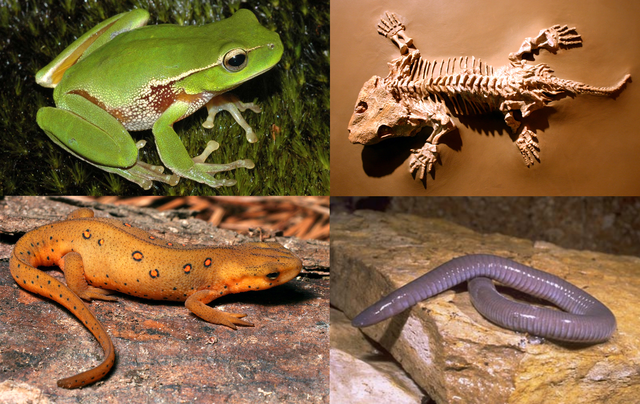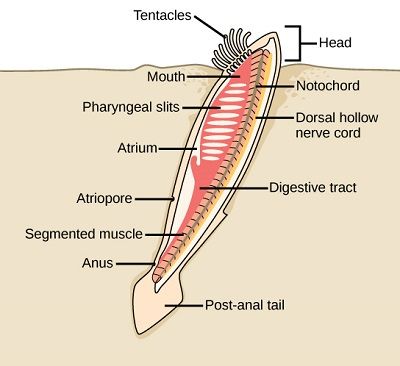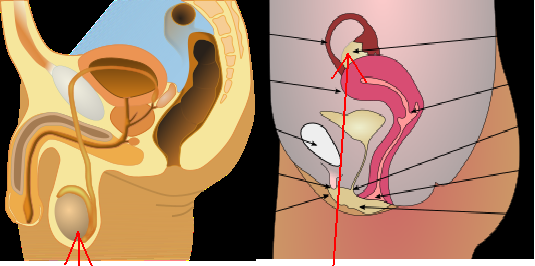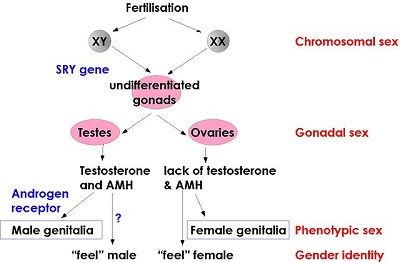Vertebrates and Sex determination
Good day gentlemen and ladies of steemit, especially the amazing and ever supportive members of the steemstem community. Today, I will be taking you all through a little portion of the animal kingdom, a subdivision of the phylum Chordata, the most evolutionarily advanced group of the animal kingdom; the vertebrates, and how sex is determined within the group.

From the word "vertebrae", vertebrates consist of a group of animals with the vertebral column in the phylum Chordata. They are generally referred to as Vertebrata and have the vertebral column along with the four key features of all animals in the phylum Chordata. These features are;

- Possession of notochord which is a flexible cartilaginous rod that serves supporting functions in the body.
- Possession of a dorsal hollow nerve cord which eventually becomes nervous tissues during embryogenesis.
- Possession of pharyngeal gill slit which is an opening between the throat and the outside, extensively modified in different groups of vertebrates and hence serve different functions.
- Possession of post anal tail which is an extension of the notochord or the nerve chord past the anus. The tail is modified in different vertebrate groups and lost in some. It serves varieties of functions according to modifications including balancing, signaling and defense.
Before taking a deep look at the evolution of sex chromosomes within the vertebrates, it is imperative to talk briefly about the subdivisions of the vertebrates. There are five groups of organisms in the vertebrates namely:
- Fishes
- Amphibians
- Reptiles
- Birds
- Mammals
The fishes are collectively called Pisces. They are exclusively adapted to living in water from where they obtained their oxygen through the use of their gills or lungs as the case may be. The organ for locomotion in water is the fin, they do this by swimming. When it is time to reproduce, the females lay soft-shelled eggs in water while the males shed sperm on it. Hence, fertilization is external. However, exemption occurs in the case of sharks where fertilization is internal and the females give birth to young ones. Temperature of the internal environment of the bodies of fishes varies along with that of the external environment, meaning they are poikilothermic.
The amphibians are evolutionarily more advanced than the fishes. They are biologically adapted to staying in water and on land and the first group of vertebrates to move to land. Usually, the young ones are fully adapted to life in water where they undergo series of metamorphosis to give rise to an adult organism which is adapted to living on land. While in water, gills are usually used for gaseous exchange while lungs are used in place of gills on land together with the unique ability to carry out gaseous exchange through skin surfaces as the case may be. Just like the Pisces, Amphibians are also poikilothermic.
Next in the evolutionary ladder of the vertebrates is Reptile which consists of a group of organisms that are fully adapted to terrestrial habitats unlike Pisces and Amphibians. Full adaptation to terrestrial environment has its challenges in that organisms suffer from desiccation, a condition that is overcomed by reptiles through the development of thick scaly skins and laying of hard-shelled eggs in the process of reproduction. Fertilization is usually internal and reptiles are largely poikilothermic. However, reptiles like crocodiles, sea turtles, penguins and some species of snake are water dwellers. Such reptiles however, lay their eggs on dry land during reproduction and usually need to come out of water in order to breathe since the only organ of respiration is the lung.
Next in line in the vertebrates according evolutionary advancement is birds which are collectively known as aves. They are endothermic animals with feathers and toothless beaks. They are thought to have evolved from reptiles and consist of various species of birds. They also lay hard shelled eggs, fertilization is internal and they have homeothermic body system.
The most evolutionarily advanced group of animals in the vertebrates is the mammals. One of the distinguishing features of mammals is the possession of mammary gland which confers the ability to suckle their young ones with milk on the group. This is in addition to another characteristic such as possession of hair on bodies, with exception found in whales.
Sex determination in vertebrates
A lot of organisms exist as either male or female. These organisms have distinguishing features that separate the two genders from each other either physically, or within their biological systems. This is simply referred to as sexual differentiation. A deep look into the genomic analysis of each of the gender will reveal that most of sexually differentiated organisms have gender specific chromosome that confers maleness or femaleness onto them. Basically, such organisms have two types of chromosomes within their genomes; the sex conferring chromosome which is also known as sex chromosomes and other forms of chromosomes which are known as autosomes.
Genetic sex determination is the most common form of sex determination in sexually differentiated organisms with environment or external sex determination playing keyroles in some. External sex determination in vertebrates involve temperature sex determination. Varying form of sex determination including genetic and external are found in Pisces, Amphibians and Reptiles while birds and mammals are strictly limited to genetic sex determination.

In temperature sex determination, the temperature at which an egg is incubated during a temperature-sensitive period generally determines the sex of the offspring that hatches from such egg. It has been found to be peculiar to some species of reptiles, including alligators, some turtles, and the tuatara.
Species that exhibit temperature-dependent sex determination can either make use of pattern I or pattern II temperature sex determination. In pattern I, hot temperatures basically result in the offspring being one sex while cooler temperature results in the offspring being the other sex with exposure to either ends of extreme temperatures resultingin one sex and exposure of the egg to normal temperature resulting in the other in pattern II. As such, the temperatures required to create either male or female offsprings are referred to as male-promoting or female-promoting temperatures as the case may be.
Sex determination in Pisces is either genetically or environmentally based and their sexualities have been classified by researchers as gonochorism/sequential hermaphrodite or unisexual reproduction. Organisms that display sequential hermaphroditism sexuality often change their sex at some specific points in the entire lives. Example of such species have been recorded in 27 of 448 families across 7 orders of fishes, and a whole lot of them have been opined to have establish a niche in coral reefs.
However, some fish species exhibit XX/XY and a more common ZW/ZZ sex determination system while a third type, a rare WXZ system has been characterized in platyfishes. It is pertinent to note that very few species of fishes have morphologically differentiated sex chromosomes and for most of them that have it, it is still at an early stage of differentiation.
Along with temperature sex determination, two systems of sex chromosome determinations have been identified in amphibians: a XX/XY system with heterogametic male and a ZZ/ZW system with heterogametic female although most of them do not exhibit morpologically distinguishable chromosomes. Additionally, up till now, the sex determining genes of some species of amphibians are still unknown.
Aside from temperature dependent sex determination which is common in reptiles such as turtles and some other reptilian species, recognizable sex chromosomes have been found by researchers in lizard and snakes. A number of genes involved in mammalian sex determination have also been found by researchers in reptiles although their mode of actions is not yet understood. A particular hormone, oestrogen has also been found to be essential in sex determination, especially for ovary to develop and without it, testis have been found to develop in place of ovary.
In birds and mammals, sex determination is strictly genetic or genotypic. The sex chromosomes are recognizable as Z and W with the male being the homomorphic or homogametic sex and the female being heteromorphic or heterogametic sex. Hence, the male's sex chromosome is designated as ZZ while the female's sex chromosome is designated as ZW. The Z sex chromosome has been found to contain virtually all the known sex-linked genes in birds and identified as the fourth largest chromosome in a typical bird's chromosome karyotype. The W sex chromosome is smaller and generally contains a large sequence of repeated DNA bases.
In mammals, there are two types of sex determinations, namely; primary and secondary sex determination. The primary sexy determination is largely determined chromosomally. The female is homogametic with XX sex chromosome while the male is heterogametic with XY sex chromosome. The Y chromosome has been found to be a carrier of testis-determining gene. The female mammals produce only Y eggs while the male mammals produce both X and Y sperms. A zygote that forms from the fusion of X egg and X sperm will turn out to be a female while the one that forms from the fusion of X egg and Y sperm will turn out to be a male.

While the primary sex determination directly affects the gonads of mammals, secondary sex determination affects the body phenotype. The male mammals usually have penis, a sperm producing seminal vescle and prostate glands while a female has vagina, cervix, uterus, oviduct and mammary gland to nourish their young ones. Each sex in some mammalian species has its own peculiar size, vocal cartilage and musculature. These listed secondary sex characteristics are induced by an hormone secreted by the gonads, the removal of which has been found to lead to the generation of female phenotypes.
Summary
The evolution of sex determining mechanisms within the vertebrates is still an active area of research and is yet to be fully understood. While the mechanism is genetically determined in some species of the vertebrates, it is environmentallly/externally determined in some with temperature-dependent sex determination taking a center stage. A mix of both genetic and temperature-dependent sex determination is found in vertebrate groups such as fishes, amphibians and reptiles while sex determination is strictly genetically based in birds and mammals. Both primary and secondary sex determination is found in mammals.
Thank you for your aundience.
References
If you write STEM (Science, Technology, Engineering, and Mathematics) related posts, consider joining #steemSTEM on discord here. If you are from Nigeria, you may want to include the #stemng tag in your post. You can visit this blog by @stemng for more details. You can also check this blog post by @steemstem here and this guidelines here for help on how to be a member of @steemstem. Please also check this blog post from @steemstem on proper use of images devoid of copyright issues here


Another awesome work from the stable of hadji. Amazing and well articulated write-up. I feel significantly educated. thanks
This post has been upvoted and picked by Daily Picked #39! Thank you for the cool and quality content. Keep going!
Don’t forget I’m not a robot. I explore, read, upvote and share manually ☺️
What a marvelous, well written and well researched post. It could be a college lecture.
I'd like to invite you to join the Adsactly Discord. You would find a warm and supportive community. https://discord.gg/r9YbnQ
Good one here. These are some of the facts we had to come to terms with to pass out WASSCE years ago. I was so sure I'd forgotten a lot of them, but this brought them to mind again.
I like the way you made this post explicit. It's quite easy for someone who doesn't have much foundation in biological science to grasp.
Well done!
Hi LOVE YOUR POST MAN!!! LIKE MY POST TOO!!!!! HERE IS THE LINK: https://steemit.com/bots/@abusereports/last-minute-upvote-list-2018-05-02